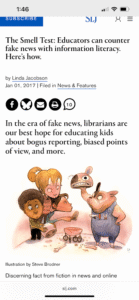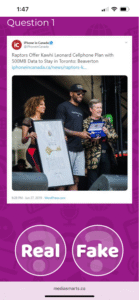
Source: Beder, S. (2018). Clickbait. Business Managed Culture Democracy. https://www.herinst.org/BusinessManagedDemocracy/culture/socialmedia/Clickbait.html
This week, I’ve been thinking about how increasing our digital literacy is one of the most powerful tools we have to protect ourselves–and our students–from the dangers of fake news. I can confidently say myself, I have been caught believing way to many stories online or images/videos that were not real or completely fake news. Now with the power of AI profound in our generation, their tools they are able to trick us by progressively continue to become more real looking then they should be. As fake news can trick almost everyone, especially in young learners like those in grade 2, it’s possible to lay foundational skills that can help them think critically, ask questions, and begin the navigate the digital world with curiosity and caution.
What Might Digital Literacy Look Like in Grade 2?
Teaching digital literacy to seven and eight year old’s might not involve deep dives into bias charts or new source databases like it would with older students. However, it can begin with simple, age appropriate activities that introduce key ideas:
“What makes something true or trustworthy?”
“Who is the author, and what do they want us to believe?”
“Can we find this same information else where?”
One of my favourite ideas from Mike Caulfields’s Web Literacy for student fact checkers is lateral reading–teaching students to open new tabs and check what others are saying about a claim. For Grade 2, this could look like comparing two kid-friendly sources about an animal or science topic, or looking up an unknown word or picture in more than one place. The tree octopus site is a perfect example of this idea.

Source: Fester, J. Save the Tree Octopus! Helping Students Develop Critical Thinking Skills. KQED. https://www.kqed.org/education/531201/save-the-tree-octopus-helping-students-develop-critical-thinking-skills
Ties to the Curriculum
In the Saskatchewan Grade 2 curriculum, I see strong connections to:
- English Language Arts (ELA):
- CR2.3 – Listen and retell (with support from the text) the key literal and inferential ideas (messages) and important details heard in small- and large-group activities, and follow oral directions and demonstrations.
- CC2.2 – Use a variety of ways to represent understanding and to communicate ideas, procedures, stories, and feelings in a clear manner with essential details.
- AR2.1 – Reflect on and assess their viewing, listening, reading, speaking, writing, and other representing experiences and strategies by participating in discussions and relating work to a set of criteria (e.g., “What did I learn?”).
- Health Education:
- USC2.5 – Recognize potential safety risks in community “play areas” and determine safe practices/behaviours to identify, assess, and reduce the risks.
- Social Studies:
- DR2.1 – Investigate stories of significant events and persons in the local community’s history to describe the contribution of those who lived in the community in earlier times.
Incorporating the NCTE Framework
The NCTE Framework for the 21st Century Literacies emphasizes:
- Building critical thinking and problem-solving
- Creating, analyzing, and evaluating multi-media texts
- Developing social responsibility and ethical participation in digital spaces
In Grade 2, this might look like:
- Evaluating short articles or videos to discuss who made them and why (e.g. using “The Smell Test: Educators can counter fake news with information literacy” as a model to simplify bias discussions)
- Doing a hands-on activity with real and fake headlines (e.g., from Can You Spot the Fake News Headline? Quiz).
- Creating class anchor charts on “What makes a trustworthy source?”

Source: Jacobson, L. (2017). The Smell Test: Educators can counter fake news with information literacy. School Library Journal. https://www.slj.com/story/the-smell-test-educators-can-counter-fake-news-with-information-literacy-heres-how

Source: Media Smarts. (2025). Can you spot the fake news quiz. Media Smarts. https://pressbooks.pub/webliteracy/
Why This Matters to Me
In a world where children are growing up surrounded by screens, I believe it’s never too early to start teaching them to think critically about what they see online. Even at work recently, a student told me she saw a Youtube video where someone claimed the Titanic was fake–crazy, right? But to her, it was believable because it was presented confidently and looked like a real video. That moment really stuck to me. It reminded me that if we don’t help children learn to pause, questions, and verify, they’re vulnerable to believing anything they see. Teaching digital literacy isn’t just about media–it’s about protecting their curiosity and helping them grow into thoughtful, responsible citizens. 

Leave a Reply